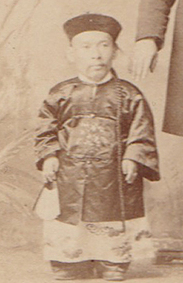Che Mah
Che Mah was a notable figure in the late 19th and early 20th centuries, recognized for her unique physical characteristics and her participation in circus and sideshow exhibitions. Born in 1838, Che Mah stood out due to her extremely small stature, which was a result of a form of dwarfism. Throughout her life, she toured with various circuses and sideshow attractions, where she was often presented as a curiosity or marvel to audiences across the United States and Europe.
Early Life[edit | edit source]
Little is known about Che Mah's early life, including her place of birth, which is often cited as being in China. The lack of detailed records makes it difficult to trace her origins or understand the circumstances that led to her career in sideshows. What is clear, however, is that by the time she reached adulthood, Che Mah had entered the world of traveling entertainment, a common practice for individuals with unique physical attributes during that era.
Career[edit | edit source]
Che Mah's career in the entertainment industry spanned several decades. She was often billed as the "Smallest Woman in the World," a title that attracted significant attention and drew crowds wherever she performed. Her act typically involved her engaging with the audience, showcasing her size in comparison to everyday objects, and sometimes performing simple tricks or dances.
Throughout her career, Che Mah worked with several well-known entertainment companies, including the Barnum & Bailey Circus. Her popularity was not just limited to live performances; she also appeared in various promotional materials and photographs, which contributed to her widespread recognition.
Later Life and Legacy[edit | edit source]
Che Mah retired from performing in the early 20th century and passed away in 1926. Despite the end of her career and her passing, she remains a subject of interest among historians and enthusiasts of circus and sideshow history. Her life and career are often cited as examples of the complex dynamics of entertainment, exploitation, and the human fascination with physical differences during her time.
Che Mah's story also contributes to the broader understanding of how individuals with unique physical characteristics were viewed and treated in the past. It raises important questions about dignity, consent, and the ethics of sideshow attractions, which continue to be relevant in discussions about entertainment and human rights today.
See Also[edit | edit source]
Search WikiMD
Ad.Tired of being Overweight? Try W8MD's physician weight loss program.
Semaglutide (Ozempic / Wegovy and Tirzepatide (Mounjaro / Zepbound) available.
Advertise on WikiMD
|
WikiMD's Wellness Encyclopedia |
| Let Food Be Thy Medicine Medicine Thy Food - Hippocrates |
Translate this page: - East Asian
中文,
日本,
한국어,
South Asian
हिन्दी,
தமிழ்,
తెలుగు,
Urdu,
ಕನ್ನಡ,
Southeast Asian
Indonesian,
Vietnamese,
Thai,
မြန်မာဘာသာ,
বাংলা
European
español,
Deutsch,
français,
Greek,
português do Brasil,
polski,
română,
русский,
Nederlands,
norsk,
svenska,
suomi,
Italian
Middle Eastern & African
عربى,
Turkish,
Persian,
Hebrew,
Afrikaans,
isiZulu,
Kiswahili,
Other
Bulgarian,
Hungarian,
Czech,
Swedish,
മലയാളം,
मराठी,
ਪੰਜਾਬੀ,
ગુજરાતી,
Portuguese,
Ukrainian
Medical Disclaimer: WikiMD is not a substitute for professional medical advice. The information on WikiMD is provided as an information resource only, may be incorrect, outdated or misleading, and is not to be used or relied on for any diagnostic or treatment purposes. Please consult your health care provider before making any healthcare decisions or for guidance about a specific medical condition. WikiMD expressly disclaims responsibility, and shall have no liability, for any damages, loss, injury, or liability whatsoever suffered as a result of your reliance on the information contained in this site. By visiting this site you agree to the foregoing terms and conditions, which may from time to time be changed or supplemented by WikiMD. If you do not agree to the foregoing terms and conditions, you should not enter or use this site. See full disclaimer.
Credits:Most images are courtesy of Wikimedia commons, and templates Wikipedia, licensed under CC BY SA or similar.
Contributors: Prab R. Tumpati, MD

